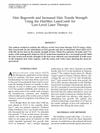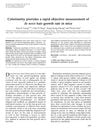TLDR Colorimetry can accurately measure hair growth rates in mice.
The study demonstrated that tristimulus colorimetry, specifically the L* value, provided a sensitive and quantitative measure of de novo hair growth in depilated mice. The method was tested on agouti, albino, and black mice, and it was found that L* values changed significantly during the anagen phase. LED irradiation at 890 nm promoted hair regrowth, while 650 nm had an inhibitory effect. The hair growth rates measured by colorimetry were consistent with those observed through global assessment, suggesting that colorimetry could be a reliable tool for projecting hair growth rates in mice.
63 citations
,
January 2006 in “Journal of cosmetic and laser therapy” The pulsed infrared diode laser is effective for treating hair loss in alopecia areata.
85 citations
,
November 2004 in “Journal of the American Academy of Dermatology” The 308-nm excimer laser helps hair regrowth in some alopecia areata cases but not all.
 75 citations
,
August 2003 in “International journal of cosmetic surgery and aesthetic dermatology”
75 citations
,
August 2003 in “International journal of cosmetic surgery and aesthetic dermatology” The HairMax LaserComb made hair grow more and get stronger for people with hair loss.
 86 citations
,
February 2003 in “Journal of The American Academy of Dermatology”
86 citations
,
February 2003 in “Journal of The American Academy of Dermatology” New methods improve how we test hair growth treatments, but challenges like slow hair changes and high costs remain.
63 citations
,
February 2003 in “Australasian Journal of Dermatology” Global photography and phototrichogram techniques are the best current methods for measuring hair growth.
 15 citations
,
April 2001 in “Journal of Dermatological Science”
15 citations
,
April 2001 in “Journal of Dermatological Science” KF19418 promotes hair growth similarly to minoxidil but is not better in live mice.
 4 citations
,
October 2009 in “Skin research and technology”
4 citations
,
October 2009 in “Skin research and technology” Colorimetry can accurately measure hair growth rates in mice.




